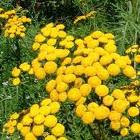AFRICAN SHEA TREE, KARITE, VITELLARIA PARADOXA
The Shea tree is native to the African continent and is propagated by fruit bats. It was formerly called Butyrospermum parkii or Butyrospermum paradoxa although it is now known as Vitellaria paradoxa. The name Butyrospermum means butter seed which is a good description as the seeds is the producer of shea butter which is used in cosmetics. The parkii part of its former name was in honour of the Scot, Mungo Parks Niger River and who was the first European to describe this tree in the 1790s in his book “Life and Travels of Mungo Park in Central Africa.”
 The tree has spreading branches resembling an oak tree and the fruit looks a little like chikoo or sapodilla to which it is related as both trees are members of the Sapotaceae family. The tree can grow to heights of between 25 and 75 feet (7.6 metres to 22.7m.) Trees begin to produce fruit when they are between 10 and 15 years old, and reach peak production when they are 20 to 30 years old, although they can continue producing fruit the size of large plums, for two hundred years.
The tree has spreading branches resembling an oak tree and the fruit looks a little like chikoo or sapodilla to which it is related as both trees are members of the Sapotaceae family. The tree can grow to heights of between 25 and 75 feet (7.6 metres to 22.7m.) Trees begin to produce fruit when they are between 10 and 15 years old, and reach peak production when they are 20 to 30 years old, although they can continue producing fruit the size of large plums, for two hundred years. It is the kernels which are enclosed by the pulpy flesh which produce the shea oil or butter which is called ‘women’s gold” in the countries where it is grown as money from producing the oil and butter goes to the women who process the kernel painstakingly. Nowadays there are initiatives helping women to market their produce to European and Asian countries where it is valued not only for its inclusion in cosmetics but also as a partial substitute for cocoa butter and used in chocolate making.
The tree, like the baobab tree is known as the tree of life, karite, as it provides food and medicine for the people who live in the regions where it grows wild. The fruit contains four times as much vitamin C as oranges, and the oil has vitamins A and E in it. The kernel is rich in oleic, arachidic, palmitic, stearic and linoleic fatty acids.
All parts of the tree are used in medicine, for skin diseases including leprosy, dermatitis and eczema, to protect from sunburn, as the oil can counter harmful ultra-violet rays from the sun, and also soothe sunburn. It is also used for wounds and to massage into stiff joints, as well as to treat sore and injuries of animals. The roots are used for cleaning the teeth and oral health in the same way as the walnut tree bark is used in Pakistan
 The oil and/or butter is also used in religious ceremonies or spiritual purification and to anoint the dead. The rubbery sap or latex from the tree is used as glue and for children’s balls and as chewing gum, while the black residue from the butter-making process is used to fill cracks and to waterproof buildings.
The oil and/or butter is also used in religious ceremonies or spiritual purification and to anoint the dead. The rubbery sap or latex from the tree is used as glue and for children’s balls and as chewing gum, while the black residue from the butter-making process is used to fill cracks and to waterproof buildings. The European Union’s 2003 directive allows a percentage of shea butter to be substituted for cocoa butter in the chocolate industry and even as early as the 1940s shea butter was used in the West to make margarine. The tree is protected but is sometimes felled illegally because of the need to survive, whether that is to clear land to plant crops or to use the wood for fuel to cook food.
An Australian study published in the Journal of Phytotherapy Research in 2010 concluded that a supplement containing shea butter could help to relieve joint inflammation. Other research indicates that the stem bark has antimicrobial properties, as do the leaves to a lesser degree. (“Phytochemical and antimicrobial screening of the crude extracts from the root stem bark and leaves of Vitellaria paradoxa (GAERTN. F)” African Journal of Biotechnology Vol. 6 (16) pp 1905-09; 20th August 2007 )
Other studies have shown that the butter or oil can be rubbed into the interior of the nose to give relief from nasal congestion and sinusitis for several hours, and the vitamin E content of the butter helps to prevent wrinkles, protect from atmospheric pollutants as well as being a useful sunscreen.
If you ever get to eat the fruit, which according to some reports tastes a bit like a fig, then you will benefit from its antioxidant properties which are believed to be caused by the catechins (phenolic compounds or bioflavonoids) in it.
Clearly this tree has potential for future medicinal use as well as being of economic and religious importance to the people in the regions where it grows. The fruit is also important for its vitamin content and nutrition.





















































